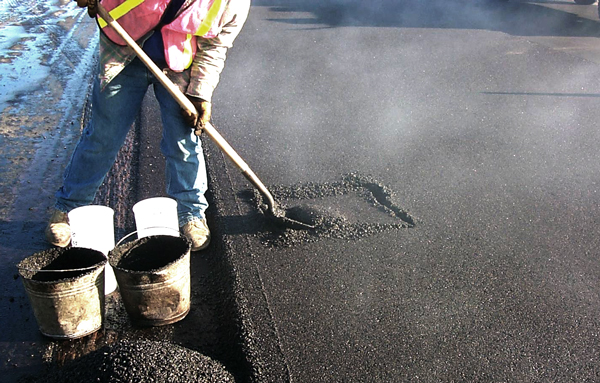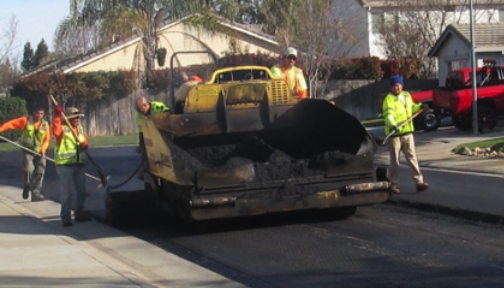Boost the Look of Your Property with Expert Commercial Parking Lot Paving
Boost the Look of Your Property with Expert Commercial Parking Lot Paving
Blog Article
Opening the Keys of Warm Mix Asphalt Modern Technology
Discovering the midsts of warm mix asphalt modern technology reveals a globe where meticulous procedures and specific solutions merge to form our roadways and facilities. The combination of aggregates, binders, and fillers isn't simply a building task but a strategic orchestration of durability and performance. As we peer right into the complex dance of components, a tapestry of resilience and sustainability unravels. What exists below this surface of asphaltic proficiency, and what tricks wait to be unveiled in the world of leading developments?
Relevance of Warm Mix Asphalt
Warm Mix Asphalt plays an important duty in contemporary facilities growth due to its toughness and cost-effectiveness. As one of the most commonly utilized leading material for roadways, freeways, and parking area, Hot Mix Asphalt supplies a series of advantages that add to its significance in building tasks. One essential benefit is its capacity to endure hefty website traffic loads and extreme weather, offering a trustworthy and durable surface for transportation networks. Furthermore, Warm Mix Asphalt is cost-efficient in both initial construction and long-lasting upkeep, making it a recommended selection for many infrastructure jobs.
The longevity of Warm Mix Asphalt stems from its make-up, which includes accumulations, binder, and filler materials that are carefully chosen and mixed to fulfill particular efficiency demands. Overall, the relevance of Hot Mix Asphalt in framework advancement can not be understated, as it proceeds to be a cornerstone of contemporary construction techniques.
Components of Asphalt Mixes
The structure of asphalt blends is composed of carefully chosen accumulations, binder, and filler products that are critical for achieving particular performance demands. Accumulations are the key part of asphalt blends, providing strength and stability. The binder, usually asphalt or asphalt concrete, holds the accumulations with each other and gives adaptability and durability to the mix.
The combination and proportion of these components play a significant function in establishing the top quality and efficiency of the asphalt mix. Designers meticulously make the mix to fulfill details needs, taking into consideration variables like website traffic quantity, environment conditions, and pavement lifespan. Proper option and harmonizing of accumulations, binder, and fillers are necessary for producing long lasting, resilient asphalt pavements.
Mixing and Manufacturing Strategies
:max_bytes(150000):strip_icc()/asphalt-worker-134249388-58cdf96f5f9b581d723f2f33.jpg)
When the accumulations are chosen, the binder, usually asphalt concrete, is included to bind the products with each other. The binder's top quality and amount dramatically influence the mix's resistance, strength, and adaptability to ecological aspects. Furthermore, fillers like hydrated lime or Portland concrete might be integrated to improve particular qualities of the asphalt mix, such as its workability or moisture resistance.
Throughout manufacturing, the aggregates and binder are heated, generally in between 250-325 ° F(121-163 ° C ), to promote blending and guarantee proper coating of the accumulations. The mixing process has to be detailed to attain a homogeneous mixture that redirected here advertises the preferred efficiency features of the asphalt. Different techniques, such as set mixing or drum blending, are utilized to achieve premium and regular asphalt blends for building jobs.
Elements Impacting Asphalt Efficiency
Aspects influencing asphalt efficiency encompass a series of variables that affect the durability, durability, and overall high quality of asphalt pavements. One crucial factor is the top quality of materials utilized in the asphalt mix. The kind and source of accumulations, the binder quality, and the ingredients all play a significant function in determining the performance of the asphalt sidewalk. The gradation of aggregates is crucial as it impacts the mix's workability, security, and resistance to rutting and cracking.

Ecological conditions likewise affect asphalt performance. Temperature level variations, wetness infiltration, and web traffic lots can all impact the architectural integrity of the pavement. Layout considerations, such as sidewalk density and drainage, are necessary in ensuring the long-lasting efficiency of the asphalt pavement. By very carefully taking into consideration these contractors, engineers and elements can enhance asphalt efficiency and boost the life span of pavements.
Lasting Practices in Asphalt Modern Technology

Furthermore, the advancement of warm-mix asphalt (WMA) technologies has obtained grip recently. WMA permits the production and positioning of asphalt blends at lower temperatures contrasted to standard hot-mix asphalt, leading to decreased power intake and greenhouse gas discharges. The use of permeable asphalt blends can help minimize stormwater overflow issues by enabling water to infiltrate via the pavement and right into the ground, promoting all-natural water filtering and recharge processes. By implementing these lasting practices, the asphalt sector can add to constructing a more eco-friendly their explanation and resistant framework network.
Verdict
In verdict, warm mix asphalt technology plays an important function in modern-day framework growth as a result of its resilience and cost-effectiveness. By very carefully stabilizing elements, using correct blending strategies, and taking into consideration numerous variables, designers can develop high-grade asphalt blends that withstand rush hour lots and rough climate condition. Welcoming lasting methods, such as utilizing warm-mix technologies and recycled materials, further boosts the ecological kindness of asphalt innovation.
Mixing and manufacturing strategies in hot mix asphalt technology involve the specific mix and processing of aggregates, binder, and fillers to develop a long lasting and high-performance asphalt mix.Elements influencing asphalt efficiency include a range of variables that influence the toughness, longevity, and general quality of asphalt sidewalks. Sustainable techniques in asphalt innovation encompass numerous efforts aimed at lowering the environmental influence of asphalt manufacturing and paving processes. By integrating reclaimed asphalt sidewalk (RAP) click to read more and recycled asphalt roof shingles (RAS) right into new asphalt blends, the market can significantly minimize the consumption of raw products and energy, while likewise decreasing garbage dump waste.
WMA permits for the production and positioning of asphalt mixes at reduced temperatures contrasted to traditional hot-mix asphalt, resulting in minimized energy usage and greenhouse gas exhausts.
Report this page